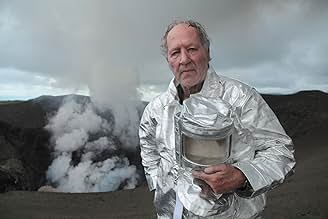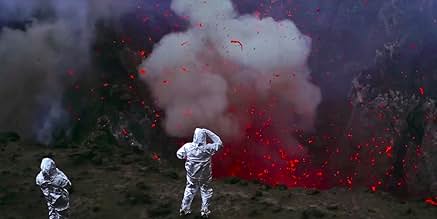IMDb रेटिंग
7.2/10
11 हज़ार
आपकी रेटिंग
अपनी भाषा में प्लॉट जोड़ेंAn exploration of active volcanoes around the world.An exploration of active volcanoes around the world.An exploration of active volcanoes around the world.
- पुरस्कार
- 5 कुल नामांकन
Maurice Krafft
- Self - Volcanologist
- (आर्काइव फ़ूटेज)
Katia Krafft
- Self - Volcanologist
- (आर्काइव फ़ूटेज)
William McIntosh
- Self - Volcanologist
- (आर्काइव फ़ूटेज)
फ़ीचर्ड समीक्षाएं
Werner Herzog proves again he is a monster of a documentarian. Into the Inferno is filled with stunning imagery and sounds that truly left me awestruck. The substance of the film itself was not quite what I was expecting, but it turned out that that was a good thing. This film goes places you would never really think of, and sheds light on many different cultural connections to volcanoes around the world. It more about people, societies, and culture than it is about science and geology, although there is some of that too. If you are at all interested in volcanoes and how people react and interact with them around the world, this film will pleasantly surprise you.
A British-Austrian documentary; Filmmaker Werner Herzog observes some of the most beautiful and terrifying wonders of the natural world - the volcano - with his signature blend of curiosity and insight. He travels round the world, to Indonesia, Ethiopia, Iceland and North Korea to explore the effect volcanos have on their population and culture and myths. The film is significant for showing a fresh insight into life in North Korea, and a fascinating insight into the fossil hunting of early humankind in the shadow of the volcano. The primordial aspect of molten lava flow and lava explosions captured on film are extraordinary and at times unsettling, such was the danger to the cameramen and the vertigo from enormous backdrops of crimson fury.
The film meanders from one location to another and unconventional in its narrative and narration. Herzog's storytelling style is not easily pinned down, though he never loses sight of one constant here: human awe for the primeval and the elemental.
This documentary does not try to scientifically explore volcanoes, it's about the emotional impact volcanoes have on human beings.
On a subjective level, looking into the red bubbling abyss was pleasant and terrifying at the same time.
On a subjective level, looking into the red bubbling abyss was pleasant and terrifying at the same time.
Werner Herzog is a captivating man who has grand pursuits and a varied set of interests. He has made many films since his breakout hit, "Aguirre, the Wrath of God," in 1972, and all of them have either been exceptionally interesting, complex, fantastical, or illuminating in nature. Herzog makes both fiction and non-fiction films that deal with issues as diverse as colonialism, the savageness of the wilderness, ecological disasters, opera, and ski flying. With his newest film for Netflix, Herzog once again shows us that fascination is an oft neglected but empowering feeling that can be applied to numerous aspects of life. He starts us off with the topic of volcanoes, but he becomes much more fascinated with humankind at large, evidenced by his own reticence to even get close to a volcano.
Herzog reels us in with the help of Clive Oppenheimer, a Cambridge University volcanologist that he had previously worked with in the documentary, "Encounters at the End of the World," which was a film about Antarctica. Oppenheimer is a playfully compelling, if timid, guide into the world of volcanoes. He and Herzog travel the world and study volcanoes in Indonesia, Iceland, North Korea, and Ethiopia. At each of these junctures, the cultural importance of the volcano is made the fixture of the film, rather than focusing on hard science. The peoples of these regions all seem to be in awe of volcanoes, and either have a deep fear or respect for what it's capable of. In Ethiopia, a nearby volcano is the key to finding fossils of Paleolithic hominids, the rarest of human fossils. In North Korea the region's fierce patriotism is linked with its local volcano where the leaders Kim Il-sung and Kim Jong-Il once stood, proudly displaying to their nation that they were strong and resilient in the face of outside vitriol.
Though some of these excursions seem to undercut the fact that this is a film about volcanoes, this film never bores its audience. Between the panoramic shots of tropical foliage and the drone sequences that pan across villages and volcanoes alike, this is a feast for the eyes. There's a great contrast between the beauty of these regions and the oft-confusing shots of the magma that these ruptures expound with horrifying regularity. The inner regions of volcanoes look both like fire and water, and the magma often looks pitifully tame when it moves slowly down a mountainside, though it is actually a most dangerous force that will destroy all in its path. Herzog talks a bit about a couple who were volcanic photographers and were eventually killed by a fast moving cloud of volcanic ash (at 100 mph). While this tidbit is unprompted, it proves to be yet another interesting facet of these quaking mountaintops. Herzog finds many ways to look at these geographic forces, which can be seen as either benevolent or destructive in power.
Herzog reels us in with the help of Clive Oppenheimer, a Cambridge University volcanologist that he had previously worked with in the documentary, "Encounters at the End of the World," which was a film about Antarctica. Oppenheimer is a playfully compelling, if timid, guide into the world of volcanoes. He and Herzog travel the world and study volcanoes in Indonesia, Iceland, North Korea, and Ethiopia. At each of these junctures, the cultural importance of the volcano is made the fixture of the film, rather than focusing on hard science. The peoples of these regions all seem to be in awe of volcanoes, and either have a deep fear or respect for what it's capable of. In Ethiopia, a nearby volcano is the key to finding fossils of Paleolithic hominids, the rarest of human fossils. In North Korea the region's fierce patriotism is linked with its local volcano where the leaders Kim Il-sung and Kim Jong-Il once stood, proudly displaying to their nation that they were strong and resilient in the face of outside vitriol.
Though some of these excursions seem to undercut the fact that this is a film about volcanoes, this film never bores its audience. Between the panoramic shots of tropical foliage and the drone sequences that pan across villages and volcanoes alike, this is a feast for the eyes. There's a great contrast between the beauty of these regions and the oft-confusing shots of the magma that these ruptures expound with horrifying regularity. The inner regions of volcanoes look both like fire and water, and the magma often looks pitifully tame when it moves slowly down a mountainside, though it is actually a most dangerous force that will destroy all in its path. Herzog talks a bit about a couple who were volcanic photographers and were eventually killed by a fast moving cloud of volcanic ash (at 100 mph). While this tidbit is unprompted, it proves to be yet another interesting facet of these quaking mountaintops. Herzog finds many ways to look at these geographic forces, which can be seen as either benevolent or destructive in power.
Whilst this film does contain some outstanding images of volcanoes, eruptions and lava, these parts are few and far between.
I was hoping for an exploration of the power and activity of volcanoes around the world, but was only given a glimpse of a few sites, with very little in terms of information about how volcanic action actually arises.
This doc focuses more on worldwide spiritual views around volcanoes, with some superficial information about the effects of eruptions on our planet.
क्या आपको पता है
- ट्रिवियाWas one of the very few movies that was filmed in North Korea.
- भाव
Werner Herzog: It is a fire that wants to burst forth and it could not care less about what we are doing up here
- साउंडट्रैकUnfailing Light
Performed by the Monks Choir of Kiev Pechersk Monastery
Traditional
Courtesy of Origen Music
टॉप पसंद
रेटिंग देने के लिए साइन-इन करें और वैयक्तिकृत सुझावों के लिए वॉचलिस्ट करें
- How long is Into the Inferno?Alexa द्वारा संचालित
विवरण
बॉक्स ऑफ़िस
- दुनिया भर में सकल
- $3,679
- चलने की अवधि
- 1 घं 44 मि(104 min)
- रंग
- पक्ष अनुपात
- 1.85 : 1
इस पेज में योगदान दें
किसी बदलाव का सुझाव दें या अनुपलब्ध कॉन्टेंट जोड़ें


















